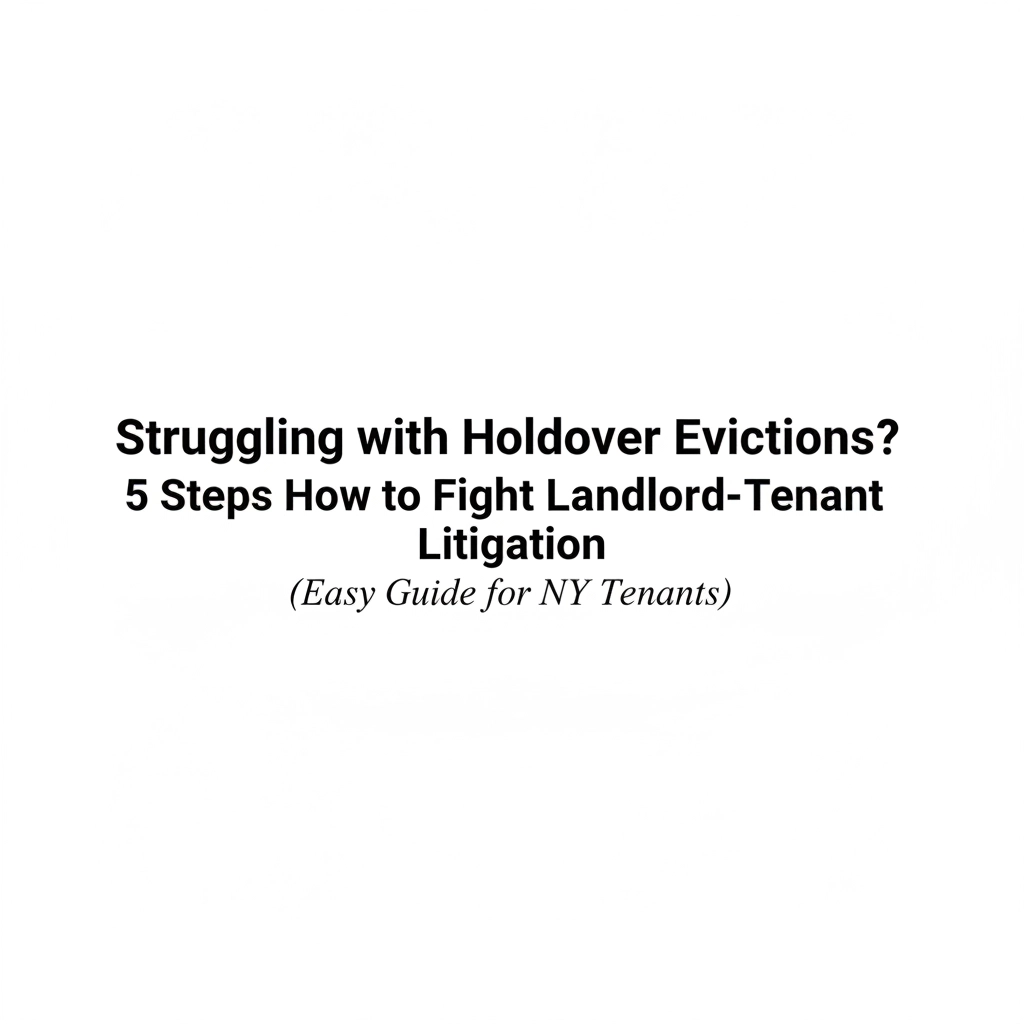In the labyrinthine world of New York landlord-tenant law, holdover evictions represent one of the most formidable challenges tenants face. Unlike the straightforward calculations of nonpayment proceedings, holdover cases thrust tenants into a complex arena where landlords seek removal for reasons unrelated to rent: creating a battlefield where legal strategy, procedural precision, and constitutional rights converge. The stakes extend far beyond mere housing stability; they encompass fundamental questions of due process, property rights, and the delicate balance between landlord authority and tenant protection under New York's intricate statutory framework.
When a holdover petition lands on your doorstep, you are not merely facing an administrative inconvenience: you are confronting a legal proceeding that demands immediate, strategic action. These cases arise when landlords allege that tenants remain in rental units without legal right, encompassing scenarios from expired leases and unauthorized occupants to alleged lease violations and nuisance claims. The subjective nature of these allegations creates both vulnerability and opportunity, as the burden of proof shifts to landlords who must substantiate their claims through evidence and legal argument rather than simple arithmetic.
Step 1: Scrutinize Notice Requirements with Surgical Precision
The foundation of every holdover eviction rests upon the landlord's compliance with New York's stringent notice requirements: a cornerstone that, when properly challenged, can topple even the most seemingly robust cases. The law demands that landlords provide appropriate notice before initiating court proceedings, with specific timeframes determined by the length of your tenancy. Tenants residing in their units for less than one year must receive thirty days' notice, those with one to two years of occupancy require sixty days, and tenants with over two years of residence are entitled to ninety days' notice.
The critical examination extends beyond mere timeframes to encompass the method and substance of service. Document meticulously how you received the notice: whether through personal service, substituted service, or posting: and verify compliance with New York's exacting service requirements. Equally important is the content analysis: does the notice accurately state the grounds for eviction? Are the alleged violations described with sufficient specificity to allow you to respond adequately?

A particularly potent defense emerges when landlords accept rent payments after serving notice. This acceptance can invalidate the entire proceeding, as it contradicts the landlord's assertion that your tenancy has terminated. Every rent payment, deposit, or fee accepted subsequent to notice service becomes ammunition in your defensive arsenal, demonstrating the landlord's acknowledgment of your continued tenancy rights.
Step 2: Deconstruct and Challenge the Underlying Claims
Holdover proceedings thrive on allegations that often prove more fragile under scrutiny than they initially appear. Unlike nonpayment cases with their mathematical certainty, holdover claims require landlords to construct compelling narratives supported by credible evidence: a burden that creates substantial opportunities for strategic defense.
If your case involves alleged lease violations, conduct a forensic examination of your lease agreement alongside the landlord's specific claims. Document contradictory evidence, witness testimony, and any circumstances that undermine the landlord's allegations. For unauthorized occupant cases, gather proof of legitimate reasons for additional residents, whether family members exercising legal rights, approved subtenants with proper documentation, or individuals whose presence falls within lease parameters.
Lease expiration cases demand particular attention to rent stabilization laws and renewal rights. Many tenants possess continuation rights under rent stabilization regulations that landlords either misunderstand or deliberately ignore. Challenge any termination of a regulated tenancy by examining the landlord's compliance with applicable statutory requirements and your potential rights to lease renewal or succession.
Step 3: Assert Procedural Defenses as Constitutional Safeguards
New York's landlord-tenant laws form an intricate web of procedural requirements that serve as constitutional safeguards protecting tenant rights. These procedures are not mere formalities but essential protections that, when violated, can provide complete defenses to eviction. Your defensive strategy must encompass a comprehensive audit of every procedural step in your case.
Examine the court papers for technical defects, including improper party designations, insufficient descriptions of the premises, or failures to include required statutory language. If you occupy a rent-stabilized apartment, scrutinize the landlord's compliance with rent stabilization regulations, registration requirements, and proper rent calculation procedures. Violations of these regulations can render eviction proceedings fundamentally defective.
Service of process represents another critical vulnerability in many holdover cases. Document any irregularities in how legal papers were served, including timing violations, improper methods, or service on incorrect individuals. These procedural defenses often prove decisive in complex holdover litigation, transforming technical compliance from administrative burden into powerful tenant protection.
Step 4: Marshal Evidence and Prepare Comprehensive Court Defense
The courtroom battle in holdover cases demands meticulous preparation and strategic presentation of evidence. Unlike nonpayment proceedings with their focus on payment records, holdover defenses require comprehensive documentation spanning lease terms, communications, property conditions, and factual circumstances surrounding the landlord's allegations.
Compile all relevant documentation, including your original lease agreement, correspondence with the landlord, photographs documenting apartment conditions, and records of rent payments and maintenance requests. Organize witness testimony from neighbors, family members, or others who can support your defense narrative. These witnesses can provide crucial testimony regarding your occupancy patterns, compliance with lease terms, or the landlord's conduct.

Prepare written answers to the landlord's petition that clearly articulate your defenses and any counterclaims you may possess. Consider whether warranty of habitability violations, landlord harassment, or other tenant protection law violations could serve as defensive strategies or affirmative claims. These counterclaims can shift the litigation dynamic, transforming you from a passive defendant into an active advocate for your rights.
Step 5: Secure Experienced Legal Representation Immediately
The most crucial step in defending against holdover evictions involves obtaining skilled legal representation from attorneys who understand the nuanced complexities of New York landlord-tenant law. The legal landscape governing holdover proceedings demands specialized knowledge that extends far beyond general legal principles to encompass intricate statutory requirements, procedural nuances, and strategic considerations unique to housing court practice.
Most landlords retain experienced counsel for holdover proceedings, creating an inherent disadvantage for unrepresented tenants navigating this complex legal terrain. The subjective nature of holdover claims requires sophisticated legal arguments, evidence presentation, and procedural maneuvering that prove difficult for non-lawyers to execute effectively.
If financial constraints limit your access to private counsel, pursue free legal services immediately through organizations dedicated to tenant representation. When you receive legal papers, prioritize securing legal consultation, and if representation remains unavailable by your court date, request additional time from the judge to obtain counsel. The stakes are too high, and the legal requirements too complex, to navigate these proceedings without professional guidance.
The Path Forward: Protecting Your Rights Through Strategic Defense
Holdover evictions present unique defensive opportunities precisely because they cannot rely on simple calculations or undisputed facts. Success requires challenging the landlord's legal authority to terminate your tenancy, examining compliance with procedural requirements, and identifying violations that undermine the entire proceeding. Every aspect of your case: from initial notice through final judgment: represents a potential point of defensive leverage.
The key lies in understanding that receiving a holdover petition does not mandate your departure from the premises. Instead, it initiates a legal process where your rights, properly defended, can prevail against even seemingly strong landlord claims. With comprehensive preparation, strategic legal representation, and aggressive assertion of your procedural and substantive rights, holdover cases can be successfully defended, allowing you to maintain your housing while protecting your fundamental rights under New York's tenant protection laws.
For tenants facing the uncertainty and stress of holdover proceedings, remember that you are not powerless in this process. The law provides robust protections, procedural safeguards, and defensive strategies that, when properly employed, can secure your continued occupancy and vindicate your rights. Contact experienced legal counsel immediately to begin building your defense and protecting your home through skilled legal advocacy that understands both the complexities of holdover litigation and the fundamental importance of stable housing in your life.



0 Comments